15 of the Eeriest Abandoned Hospitals and Asylums Around the World (original) (raw)
Most of these abandoned buildings are off-limits to the public for a reason!

EVA HAMBACH/Getty Images
From places of healing to horror
For some people, the allure—even the eeriness—of abandoned places draws them to dilapidated destinations year-round. For others, visiting vacant Victorians and otherwise abandoned mansions, or scrolling through images of abandoned castles, is a yearly tradition that gets them in the Halloween spirit. And when it comes to spooky structures, it doesn’t get much more creepy than abandoned hospitals and asylums.
Hospitals are vacated and left to decay for a variety of reasons—maybe a larger location is needed, buildings have been damaged and repairs are too costly, or the disease the hospital was created to treat has been eradicated. Empty, derelict hospitals can also be found in abandoned cities. Similarly, most of the psychiatric hospitals constructed in the 18th, 19th and early 20th centuries—previously known as “mental asylums”—no longer exist. Their doors were closed in the second half of the 20th century, following the development of medications used to treat mental illness and the shift away from permanent institutionalization and toward a community-based model of care.
But regardless of why their hallways went dark, there’s something unsettling about these empty medical facilities. Even if you wanted to visit them, most are closed to the public. So we’ve done the next best thing and rounded up photos of some of the most chilling abandoned hospitals and asylums in the world.
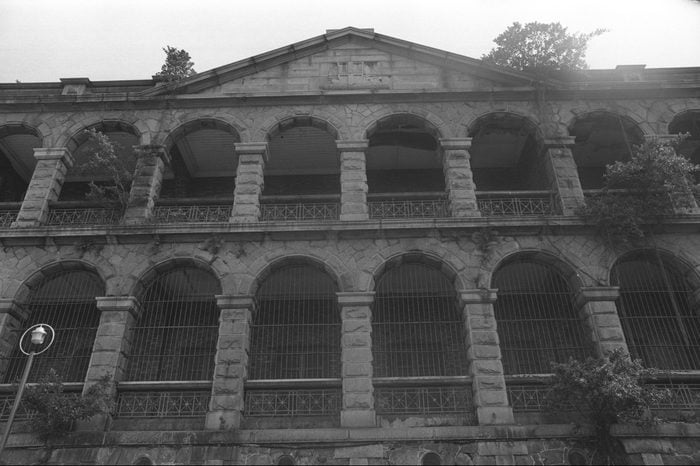
South China Morning Post/Getty Images
Old Mental Hospital
Location: Hong Kong
This eerie, now-abandoned hospital in Hong Kong’s Western District, known today as the Old Mental Hospital, has had several lives. Completed in 1892, the L-shaped building was originally constructed as quarters for the medical staff of the Government Civil Hospital. The building’s rusticated granite blocks, wide veranda and decorative pinnacles and parapets belied its next life as a psychiatric ward for the hospital’s female patients, which it was until 1961, when the Castle Peak Hospital opened. For the next 10 years, the Old Mental Hospital was used as a psychiatric outpatient treatment center, and in 1998, work began to convert it into the Sai Ying Pun Community Complex. Though most of the complex is new, the original granite facade remains, and it was declared a monument in 2015.
Ready for more? There are plenty of other creepy photos coming up.
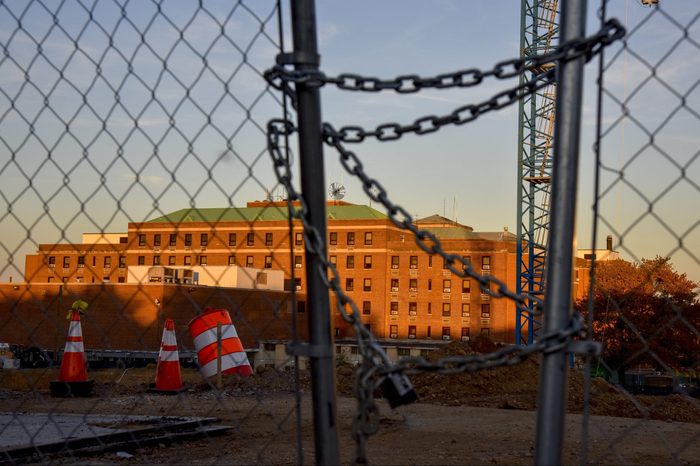
The Washington Post/Getty Images
District of Columbia General Hospital
Location: Washington, D.C.
The first public health hospital in the nation’s capital—the Washington Infirmary—was founded in 1806 as a place to care for the city’s “poor, disabled and infirm persons.” Because of its role as not only a hospital but also a workhouse and poorhouse, it was renamed the Washington Asylum, and in 1846, it moved to a larger site that would become its permanent home. Over the years, the asylum was used as a smallpox hospital, quarantine station, disinfection plant and crematory. In 1922, the city constructed a new health-care facility, Gallinger Municipal Hospital, which was renamed District of Columbia General Hospital in 1953. Following the hospital’s closure in 2001, the hospital—known as D.C. General—was used as a shelter for unhoused families until its closure in 2018. And speaking of the nation’s capital, here’s the reason Washington, D.C. is not a state.
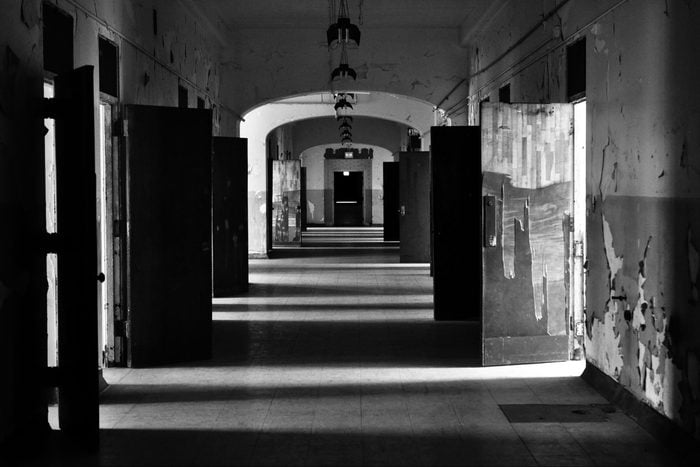
EVA HAMBACH/Getty Images
Trans-Allegheny Lunatic Asylum
Location: Weston, West Virginia
One of the most popular abandoned asylums to visit in the United States—also known as the Weston State Hospital and, ominously, the West Virginia Hospital for the Insane—the Trans-Allegheny Lunatic Asylum was constructed between 1858 and 1881. It’s often touted as the largest hand-cut stone masonry building in North America and the second-largest in the world, after the Kremlin. But regardless of its ranking, the hospital is enormous, comprising nine acres of floor space under three-and-a-half acres of roof.
Like most psychiatric hospitals of the era, the Trans-Allegheny Lunatic Asylum was intended to provide high-quality mental-health care in a state-of-the-art facility. But by the 1950s, it was overcrowded—housing roughly 2,400 patients in a building designed to hold 250—and conditions deteriorated until it closed its doors in 1994. Given that its cavernous halls are now open for tours and paranormal investigations, it’s no surprise that there are plenty of rumors related to the asylum. If you’re interested in creepy tall tales, check out these urban legends from every state.
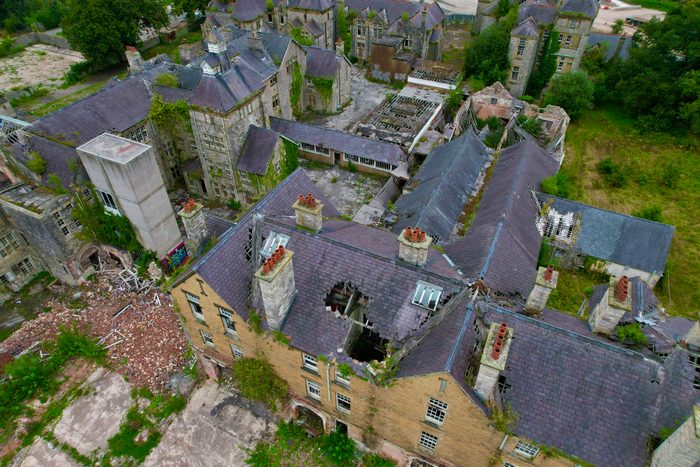
Patrick ONeill/Getty Images
North Wales Hospital
Location: Denbigh, Denbighshire, Wales
Built between 1844 and 1848, the North Wales Hospital opened as a facility for Welsh-speaking people living with mental illness. Despite three expansions, the hospital was consistently overcrowded, reaching its peak population of more than 1,500 patients in 1948. Changes in the treatment of mental illness—especially the use of medication—left patient numbers dwindling, and the hospital announced its closure in 1987.
Unfortunately, the North Wales Hospital has been abandoned since it closed in 1995, and years of neglect, vandalism and theft have left it dilapidated. The local government hopes to restore the structures, given that the hospital is considered “an exceptionally fine and pioneering example of early Victorian asylum architecture.” For now, the abandoned buildings and grounds are closed to the public. But while you can’t visit, you can check out these photos of eerie abandoned houses and abandoned car dealerships.
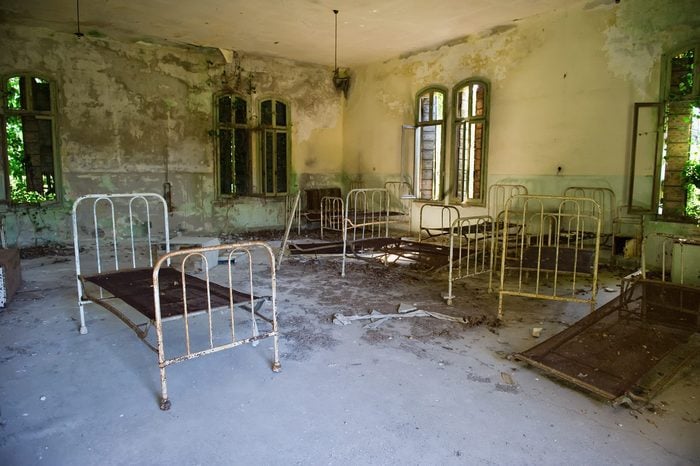
Marco Secchi/Getty Images
Poveglia Island
Location: Venice, Italy
Located in the Venetian Lagoon, Poveglia Island is a quick boat ride from St. Mark’s Square. But unlike that crowded tourist spot, it’s eerily empty. Thanks to its dark history, Poveglia has a reputation for being one of the most haunted places in Europe, making it a frequent stop for paranormal investigators. Its ties to illness go back to the 18th and 19th centuries, when the island was used as a quarantine station for ships sailing into the Port of Venice.
In 1922, Poveglia’s abandoned hospitals and other structures were converted into an asylum. A nursing home was the final medical facility to open on the island, and in 1968, the last to close. Poveglia has been uninhabited since and is not open to the public. But while many of the rumors and ghost stories associated with the island have been proven false, there are still some true urban legends out there.
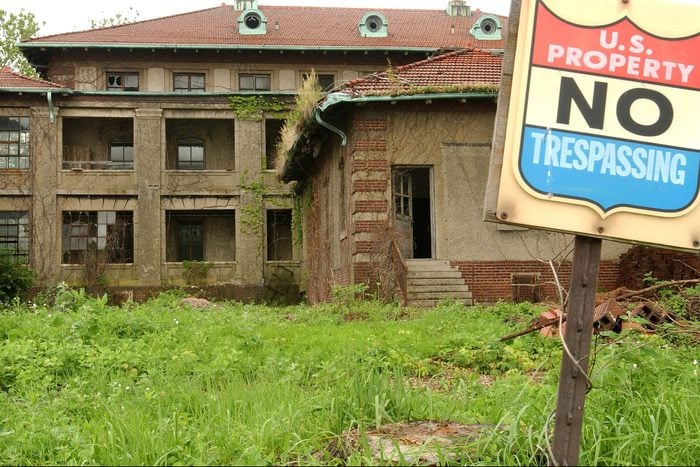
Stephen Chernin/Getty Images
Ellis Island Hospital Complex
Location: New York/New Jersey
On the south side of Ellis Island—across from the main building containing the Great Hall and what’s now an immigration museum—a hospital sat empty for more than 60 years. From 1902 through 1930, the sprawling, 29-building complex was the largest U.S. Public Health Service institution. By the time it closed in 1951, roughly 1.2 million of the 12 million immigrants who passed through Ellis Island were treated in the state-of-the-art facility.
But unlike many abandoned hospitals, this one has been welcoming visitors since 2015. That’s when the nonprofit Save Ellis Island first began offering hard-hat tours of the derelict hospital buildings—including the infectious and contagious disease ward, the kitchen, staff housing, the morgue and the laundry building where more than 3,000 pieces of laundry were once washed and sanitized daily. Proceeds from the tours go toward the continuing preservation and restoration of the complex.
If you can’t make it to New York, you can visit Ellis Island and 14 other spots around the country thanks to these virtual tours of America’s greatest landmarks.
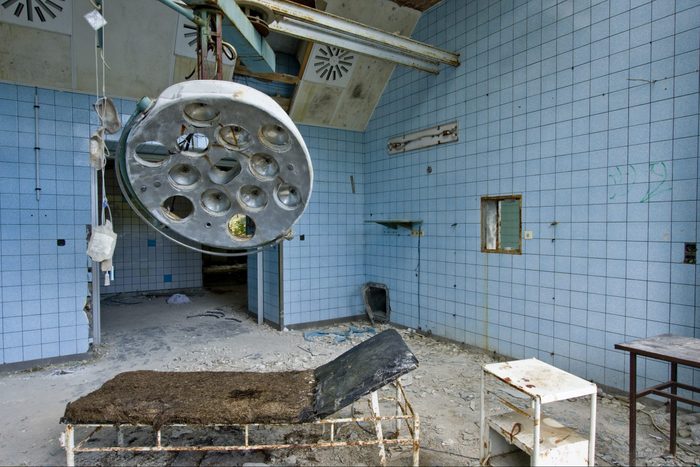
ullstein bild/Getty Images
Beelitz Heilstätten
Location: Beelitz, Germany
Some abandoned hospitals are creepy because of the way nature has taken over the formerly sanitized halls and once-state-of-the-art medical equipment, but Germany’s Beelitz Heilstätten is infamous for other reasons. The complex was built in 1898, in a forest about 30 miles outside the growing metropolis of Berlin, to treat city residents with tuberculosis. As Berlin became increasingly crowded, so did Beelitz Heilstätten. In 1928, the sanatorium expanded to accommodate 1,300 patients, with new buildings including a surgical hospital, a laundry and a shopping arcade with a cobbler, stationer, soap workshop, bakery and tailor.
During World War I, Beelitz Heilstätten was converted into a military hospital, where patients sent to recuperate after illness or injury included a young soldier from Austria named Adolf Hitler. It remained in Germany’s hands throughout World War II, until the Red Army took over the site in 1945. From 1945 through 1994, Beelitz Heilstätten was the largest Soviet military hospital outside the USSR.
The final years at Beelitz Heilstätten weren’t exactly peaceful. Between 1989 and 1991, a serial killer murdered five women and a baby on the grounds. And in December 1990, Erich Honecker—the deposed leader of East Germany—and his wife took refuge there. The Soviet Army withdrew in 1994, and the hospital complex has sat eerily empty since—just like these abandoned amusement parks.
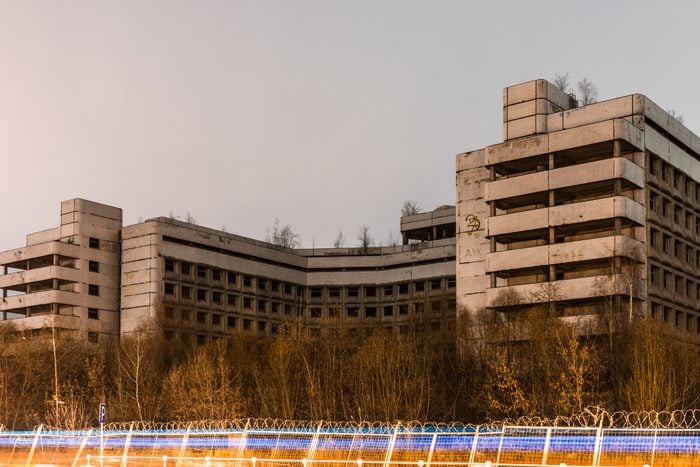
Kengoo/Getty Images
The Khovrino Hospital Complex
Location: Moscow, Russia
Fans of Brutalist architecture may be aware of the massive Khovrino hospital complex in northern Moscow. Construction of the medical facility, aka “the Umbrella,” began in 1980 but encountered a variety of problems, causing a five-year stall in progress. Though construction picked up again, the project was abandoned in 1992 due to a lack of funding, and it became a playground for everyone from urban explorers to graffiti artists to local occultists, who the Moscow Times reports were rumored to use the hospital for meetings. The fact that from above, the complex resembled a biological hazard sign didn’t help—nor did reports that several people died falling from the 11-story structure. The somewhat gloomy complex was demolished in 2018, making way for a new apartment building. For more urban ruins, take a look at these abandoned churches that are eerily gorgeous.

Louise Docker/Getty Images
Morisset Hospital
Location: Morisset, New South Wales, Australia
By the early 1900s, the two psychiatric asylums in Sydney, Australia, were beyond capacity, so the government decided to open two additional facilities, including one on the shores of Lake Macquarie in the town of Morisset. Known pointedly as Morisset Hospital for the Insane when it opened in 1909, the asylum was an industrial farm colony and a closed community for men living with mental illness. In the hospital’s early years, dormitories couldn’t be built fast enough to accommodate the influx of patients, so many lived in tents and other temporary structures as construction continued into the 1920s and ’30s.
Morisset Hospital’s first female patients and staff arrived in 1934. Another major milestone in the hospital’s history took place in the 1930s with the construction of a separate walled compound called Wyee Bay Gaol, containing two maximum security wards (Wards 21 and 22).
By 1980, the population had declined and wards had closed, and the once manicured grounds were overgrown. Ward 21 closed in 1990, and since then the complex has been home to both abandoned hospital wards and buildings still used as a psychiatric facility. For more deserted buildings, check out these abandoned hotels that will give you the chills.
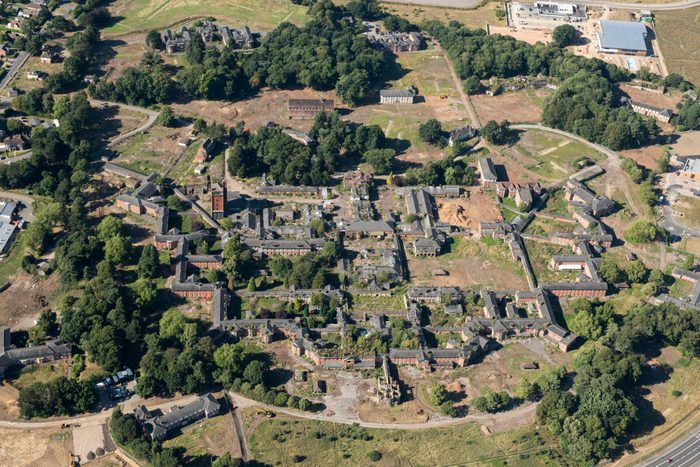
Heritage Images/Getty Images
Severalls Hospital
Location: Colchester, Essex, England
Located just north of Colchester, England, Severalls Hospital—originally known as the Second Essex County Asylum—opened its doors in 1913, housing up to 1,250 patients in 22 ward blocks. By 1937, four additional blocks had been added, bringing the capacity up to 2,000. In 1942, the German army bombed Severalls Hospital, killing 38 female patients. Other tragedies within the hospital’s walls included the use of experimental treatments—like prefrontal lobotomies—on patients in the 1940s and ’50s. (Let’s just say, if this doesn’t creep you out, you might want to try a night at one of America’s most haunted hotels.)
The patient population of Severalls gradually declined throughout the 1970s, then dropped rapidly following deinstitutionalization initiatives in the early ’80s. Buildings no longer in use were shuttered until the last elderly patients moved out of the hospital when it closed in 1997. After sitting abandoned for two decades, demolition began on some buildings to make room for new housing.
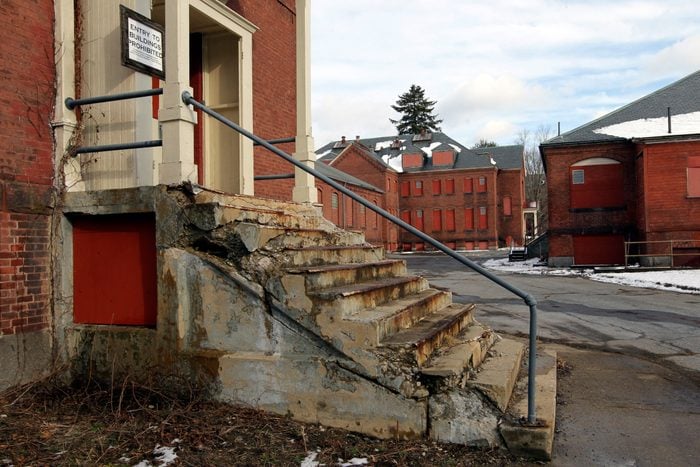
Boston Globe/Getty Images
Medfield State Hospital
Location: Medfield, Massachusetts
Originally known (ominously) as the Medfield Insane Asylum for the Chronic Insane, Medfield State Hospital opened in 1896, the first state psychiatric facility in Massachusetts built on the “cottage plan.” This meant that instead of a single, massive structure, the hospital consisted of smaller buildings that provided patients with better ventilation and access to natural light. By 1897, the complex housed 1,000 patients, and it reached its peak population of more than 2,300 patients in the 1930s and ’40s, at which point it was extremely overcrowded.
As with other now-abandoned asylums, the hospital’s patient numbers began decreasing in the 1950s, following the introduction of psychotropic medication, and continued to drop in the 1960s and ’70s, as treating people living with mental illness in long-term psychiatric facilities was discouraged. The last patients were transferred to other hospitals in 2003, and today, 44 buildings still stand on the 128-acre campus while the town of Medfield considers how to best preserve and reuse them.
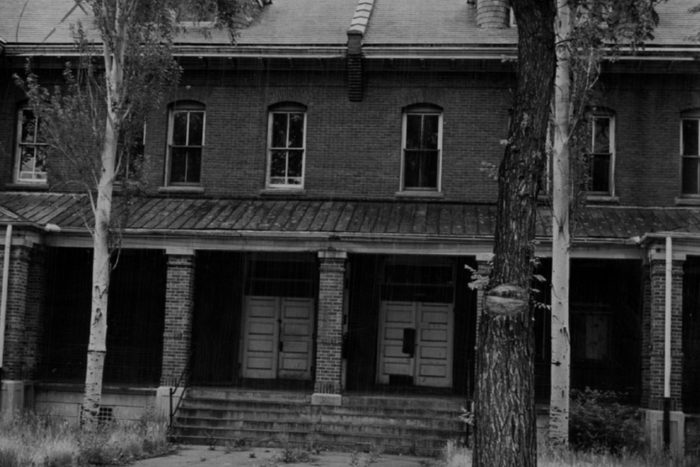
Denver Post/Getty Images
Former Hospital at Fort Logan, Colorado
Location: Fort Logan, Colorado
After years of westward colonization that included forcibly relocating Indigenous people from their lands in the eastern United States to reservations in the west, it was determined that the army needed to have a larger presence in the western territories. In 1887, a site was chosen about 10 miles from downtown Denver, and American troops moved onto the land, which was named Fort Logan. Over the next decade, multiple buildings were constructed around the 32-acre grounds, including officers’ quarters, barracks, a headquarters building, commissary, guardhouse and hospital.
From 1909 to 1922, Fort Logan operated as a recruit depot for new soldiers, and it was passed between different parts of the army until World War II, when the former medical facilities were used as a convalescent hospital. After the war, the army no longer needed the facilities and closed Fort Logan, though the Veterans Administration used the medical buildings until their new hospital in Denver was completed in 1951. Many of the fort’s original buildings remain abandoned—but still standing—as an eerie reminder of their former lives.
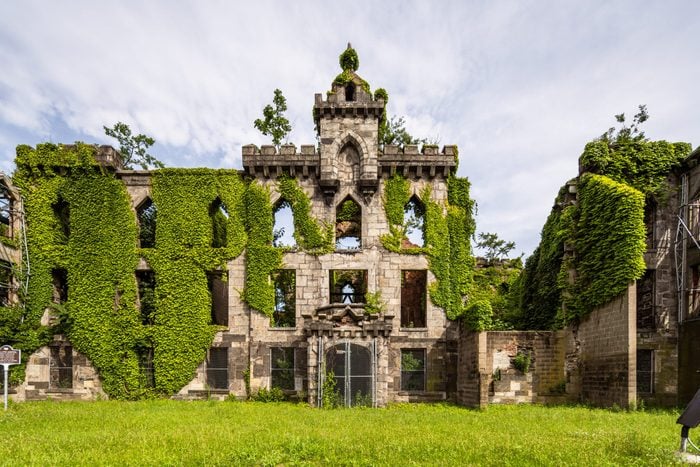
Michael Lee/Getty Images
Smallpox Hospital
Location: Roosevelt Island, New York City
Located on a narrow island in the East River, between the boroughs of Manhattan and Queens, the ruins of a smallpox hospital stand out among the skyscrapers. That’s because in a city where real estate is at a premium, what remains of the historic structure is still standing. Architect James Renwick Jr.—who’s also behind St. Patrick’s Cathedral in New York City and the Smithsonian Institution Building in Washington, D.C.—designed the Smallpox Hospital, which opened in 1865. Though New York City began vaccinating residents against smallpox in 1801, the virus continued to spread throughout the large unvaccinated population through the 1850s.
When the Smallpox Hospital was built, it was the first major hospital in the United States dedicated to treating the disease. In 1875, the city took control of the facility, renamed it Riverside Hospital and began to accept patients with other diseases as well. In 1886, Riverside Hospital closed and was converted into a nursing school, which remained in operation till the mid-1950s—leaving the hospital abandoned. After falling into disrepair in the ’60s, it became the only landmark ruin in the United States, and it’s currently registered as a federal, state and city landmark. Though the inside of the Gothic structure is off-limits to the public, it’s possible to view the hospital from its exterior, making it one of the few abandoned places in New York City you can still visit.

makasana/Getty Images
Sokołowsko Sanatorium
Location: Sokołowsko, Poland
In the early 1850s, a German physician and researcher named Dr. Hermann Brehmer hypothesized that pulmonary tuberculosis was the result of a person having a heart that was small, relative to the size of their lungs. Based on this logic, he believed that breathing air with lower levels of oxygen, found at high altitudes, could encourage tubercular patients’ hearts to grow, thus ridding them of the disease.
Brehmer’s sister-in-law owned a hydrotherapy spa in the mountain town of Görbersdorf, Germany, and in 1855, he partnered with her to open what is widely considered the world’s first sanatorium dedicated to the treatment of TB. Others soon followed, but by 1904, Brehmer’s was the largest facility of its kind, boasting more than 300 beds.
After World War II, the name of the town was changed from Görbersdorf to Sokołowsko (which is in modern-day Poland) as a tribute to Dr. Alfred Sokołowski, a Polish pulmonologist who worked at the sanatorium with Brehmer. After antibiotics that effectively treated TB were created in the 1950s, facilities like the Sokołowsko Sanatorium began to close. The buildings were ultimately abandoned, until the In Situ Contemporary Art Foundation acquired the complex in 2007.
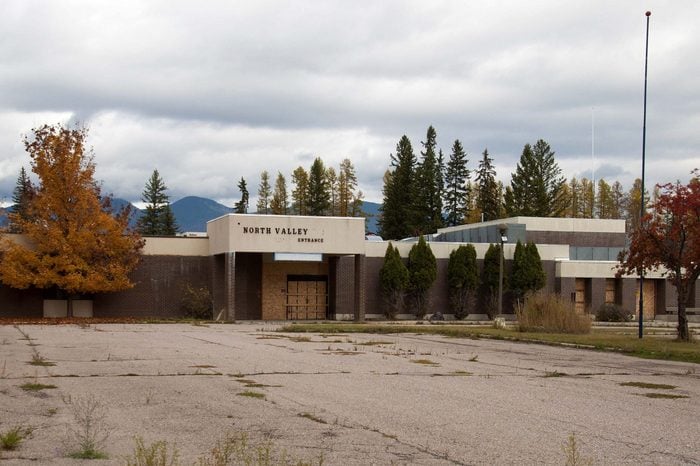
Elizabeth W. Kearley/Getty Images
North Valley Hospital
Location: Whitefish, Montana
The first iteration of the North Valley Hospital opened in 1905 in Whitefish, Montana. It was owned and operated by the Great Northern Railway until 1912 and mostly treated people injured in railroad accidents, until its closure in 1923. From 1923 until 1936, Whitefish didn’t have a hospital, but it reopened after that period and moved to a new location in 1947, where it remained throughout the 1950s and ’60s.
North Valley Hospital’s penultimate location (pictured here) opened in 1971, thanks to funding from $2 million in bonds, a federal grant and local donations. The hospital was expanded in 1975 and remodeled in 1988, and a medical office building was built next to it in 1993. The nearly 100,000-square-foot complex was abandoned when the hospital moved to its current location in 2007.
In 2013, there were talks of converting the former medical facility into a four-year college, but the plans never materialized, and the abandoned North Valley Hospital was demolished in 2016. For history that hasn’t been demolished, check out these idyllic small towns that look like they’re frozen in time.